Over the weekend at WonderCon in Anaheim, CA, CBS brought some of the people behind the scenes for a “Star Trek: Discovery Inside the Visual Effects” panel. Participating in the discussion were director and executive producer Olatunde Osunsanmi, visual effects supervisors Jason Zimmerman and Ante Dekovic, and previsualization supervisor Stephen Pavelski of Pixomondo. TrekMovie was there to bring you all the highlights.
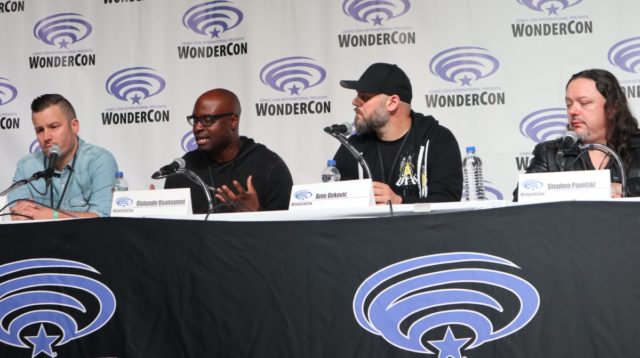
Jason Zimmerman, Olatunde Osunsanmi, Ante Dekovic, and Stephen Pavelsk at WonderCon 2019 (Photo: Josh Morgan for TrekMovie.com)
Second season challenges, from the Red Angel to Section 31 to a blinking Saurian
After briefly discussing some of their Star Trek fandom bona fides, the panel got into a discussion of some of the biggest challenges of the second season, with a consensus that the creation of the Red Angel was the toughest thing to get right. This was summed up by Osunsanmi:
The Red Angel took so many different departments to pull together correctly with costume and props. For VFX, from when Alex [Kurtzman] first came up with the idea and it was an 18-week build to build it. And the VFX has to build a full CG character of that. We have to make sure it fits on the character it has to go on. And then the VFX has to make sure it does all these wondrous things it has to do and make it look real, and legit. I think that—at least for us on the production side—took the most time. I can remember a lot of 1:00 AM phone calls with [Jason Zimmerman].
Osunsanmi also talked about the development of the Section 31 ship and how the visual effects team based in Los Angeles has to coordinate with the production team in Toronto to make everything fit:
We started with a lot of concept art and talking with J.Z.[Jason Zimmerman]… First we tried to figure out, what does the Section 31 ship do? Does it camouflage itself? What kind of technology does it have that is slightly advanced or slightly afield of where the rest of Starfleet is? The guys came up with this cool thing where it folds and it transforms and it has different shapes that it takes. Taking that into the actual environment on the set, which is a two-level environment that would fit what the exterior of the ship looked like was a challenge, but it was a lot of fun to introduce. This stuff is a lot of fun.
Another element of season two that was a challenge was the asteroid sequence in the second season premiere. Work on that was actually the first thing they started on, as explained by Zimmerman:
Previs started for that sequence while they were finalizing 115 [the season one finale]. [Alex] Kurtzman brought the idea to the team even before the script had been completed.
Zimmerman later joked that despite all the time and effort that went into that sequence, it wasn’t Kurtzman’s favorite part of the season opener:
We did that asteroid sequence and it was a massive CG undertaking, and I think Alex’s favorite thing was probably making Linus blink. He laughs every time.
Creating effects where you wouldn’t expect
The panel discussion was interspersed with a number of clips from the show, showing various visual effects passes as they went from original previsualization or on-set shot to the final. Many shots revealed how things that may have appeared to be practical effects done on set were actually CG. These included adding space suits to the characters during the space pod/asteroid sequence, duplicating background actors to create a bigger gathering at Airiam’s funeral, and adding candles in Michael Burnham’s quarters. Zimmerman also noted that usually with scenes involving blood, the blood is added by the VFX team to make it easier to shoot multiple takes on set without getting it all over the actors and costumes.
The Red Angel was also used as an example of how sometimes visual effects is called on to create an effect that would otherwise be done on set. In the episode “The Red Angel,” the entire capture sequence was done with visual effects because using an actor on location was deemed impractical, as explained by Zimmerman:
That was a good example of something when we were planning on how to shoot that, was “can we suspend this person on location, can we get the wires up?” And that is part of the reason it became CG.
Zimmerman also explained how you never know what kind of requests they may get:
It’s always the shots you don’t see coming, like when you are doing something Alex will come in and say, “Hey, let’s make the floor look different.” And okay, we are swapping out the floor.
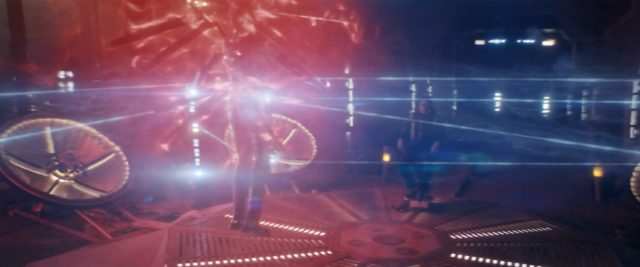
The suit for this entire sequence in “The Red Angel” was done with CG instead of suspending an actor on set
Osunsanmi noted that the people on the production side are turning to the visual effects team more and more for what otherwise would have been done on set:
We are quickly approaching the era where if you have the VFX do it, it might actually look better than doing it with practical. We are becoming more and more cognizant of that production-wise. So, as we become more conscious of that, more and more stuff gets heaped onto Jason’s plate than ordinarily would.
Zimmerman discussed how the effects team can be called on to create CG to help fix things that happened during production, like if someone scuffs up the set by accident they “clean it up.” He talked about how the process works for both planned and unplanned shots:
For the most part we kind of have an idea of what it is going to be. We try to inform it as much as possible in advance, so they do have an idea. And there will be times when we will be like “you have to go a little wider here because we have this graphic.” And then there are times where shots that are not supposed to be visual effects, become visual effects, because there is something in there. And in that case, then you look at it and that is what the shot is, what can I do with that. You kind of reverse engineer it.
Osunsanmi chimed in to note that Zimmerman was being polite:
That’s a very polite way of saying they save our…[laughs]. But they do. They come in there and if something isn’t quite where we want it to be, they do come in and save our butts.
Doing their Star Trek research and not letting effects drive the story
When discussing creating the visuals for the vision Spock was given by the Red Angel, including the destruction of a number of planets visited before by Star Trek, Zimmerman talked about how the team always starts with what has been done before:
We definitely look back at what has been done before. Trek has a very lasting legacy in visual effects and visuals in general. So, you always want to start with that. Speaking for the art department as well, they do a lot of research. They set us up really well with a lot of good concept images. And then there is a little bit of how we update that for now.
Even as the technology of visual effects improves Jason Zimmerman says Discovery will still be driven by the story:
Obviously it is served by technology, which is blisteringly fast. So, we are going to continue to grow and be able to do better versions of CG people where you are not going to be able to tell at some point. But, the one thing we can’t do with visual effects is write the story and make the story. So, it is still our job – regardless of how flashy we can get – that we have to tell the story. That is why we have to work with production and everyone else. We can make some really flashy stuff, but if at the end of the day it doesn’t tell a Star Trek story, then it doesn’t do anybody good.
Keep up with all the Star Trek: Discovery news at TrekMovie.

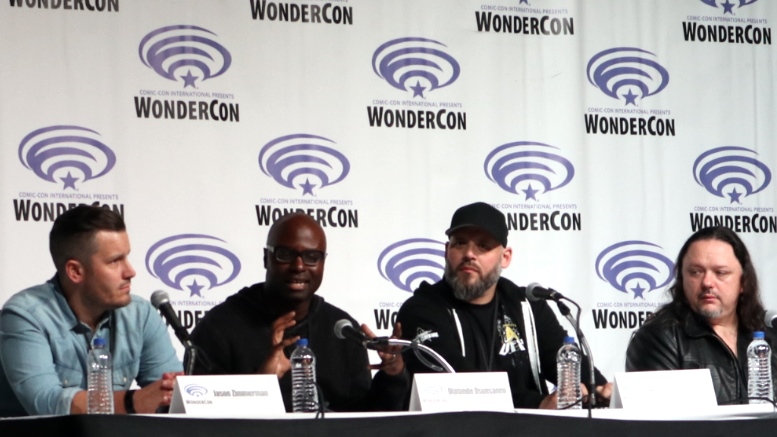
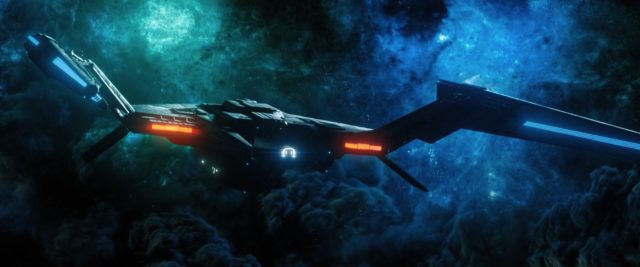
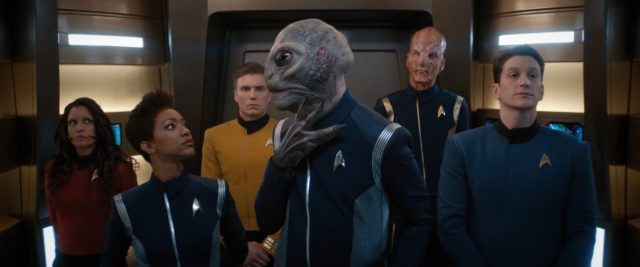
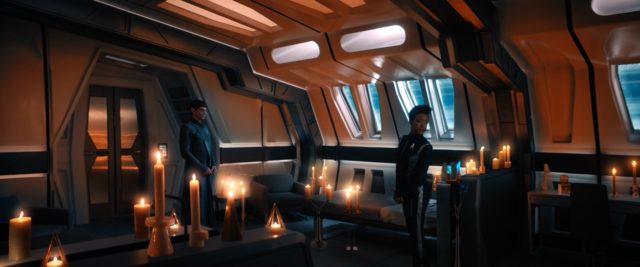

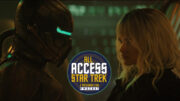
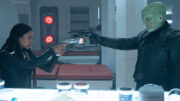

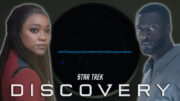
So why are there so many lens flares and so many unnecessary camera movements? Flare Trek?
Because they’re aesthetically bankrupt.
Also the reliance on CG to fix production problems is indicative of a really warped sense of getting production done. You should have to live with most production problems and work around them in editorial instead of magic wanding them, saving that for major issues. The whole dynamic of visual storytelling is ‘evolving’ away from what made cinema special in certain ways, and that’s part of the problem, more of the problem as it becomes the defacto solution.
Rude. It’s easy to post something negative in a comment. It doesn’t denote or take talent like the team you are bashing has (and gets paid well for). Jelly much? Sad.
It’s easy to some folks to become sycophantic lemmings too. Probably has something to do with one’s nature.
I don’t get the jelly reference. Also am wondering what you know about the unfortunate aspects of the vfx industry and the hours and the paydays given your comment. Don’t talk pay, stick with the talent end of your spiel, you at least have some cred there discussing that, though note I’m not talking vfx TALENT at all.
Well, I must beg to differ in this case. 2001’s visuals were groundbreaking, still the pinnacle of what was achievable with analog fx, but I’ve seen re-creations of them on YouTube, particularly with the Orion spaceplane, that were undeniably technically superior. Far as I’m concerned it’s just another workflow, and no more predestined to produce poor results than any other. And even with the occasional lens flare I’ll take DSC’s cinematic look over that of The Orville any day.
It’s an observation on kmart’s part and I don’t read it as a criticism of their work but a commentary on the idea of ‘fixing it in post’. You don’t creatively work around problems anymore, you just have the effects team go in and clean it up.
We’ve reached a point in special effects where there’s a visual sameness that has crept into a lot of effects work in television and film and it’s become increasingly rare to hear anyone ask “How did they do that?” anymore. Everyone knows. It was done in a computer.
Some of that visual sameness that you mentioned is a result of work on multiple shows being done at a lot of the same VFX houses. Some of it is because that’s what a Producer/Director will request – “Make it look like this show…” so that’s the direction that you go in. I did pre-production on a show, which I am still under NDA to not say which, but we were frequently given the direction and example of the way things were lit in Prometheus as what the Producer wanted things to look visually.
And, while yes, the audience may know that something was done in a computer, for those of us who work in the VFX industry, we still ask that question. There is work that is quite brilliantly done, that the audience will never know how much time, effort, and pain went into making it work. Seeing that kind of effort by peers drives me to constantly improve my skills and knowledge of creating things digitally.
One of the things I loved about Battlestar Galactica is that the effects group was so tightly interwoven with the overall production since everything was essentially done in-house. The effects team knew what the show wanted, the showrunners knew that they would deliver what they wanted.
Back when Sci Fi was airing Stargate, Farscape and Battlestar Galactica (back in the day when they actually embraced the concept behind the day), there was no mistaking the visual style of each show. Stargate had to reflect the feature film but was free to move beyond it. Farscape made a conscience effort from the very beginning to stand apart visually from other space epics with a heavy emphasis on color and movement and Battlestar Galactica essentially imagined present day with technology far beyond ours but familiar (and they did amazing work).
And I guess it’s a bit limiting when a project launches in the first direction provided is that ‘we want it to look like this’ as opposed to ‘we have a vision”.
Respectfully, I don’t see being able to give a single generic answer to “How did they do that?” as a good reason to do it any other way.
For me, a lot of it is whether I even care how they did that. When the work doesn’t appeal to me, I don’t usually care, except to know that’s not what I hope they do the next time. Mediocre work, or work that leverages off a dubious aesthetic, annoys me more than great work mixed with the occasional awful shot (most of the time — AIR FORCE ONE’s crash is by itself enough to keep me from rewatching the movie, even though I pretty much liked it up till that point.)
Yeah, no kidding. Discovery and the effects are amazing and well worth the price of the sub fee to CBSAA. I don’t understand the negative comments and especially coming from people who are probably not experts in the field of Special Effects or script writing.
Chris please don’t try to gatekeep by telling us we’re not experts.
Yes, many of us aren’t writers or Vfx specialists.
But neither are they for the most part scientists, engineers, strategists, military etc.
We’re interested fans, who care about the product and want it to be successful.
One of the things that can happen in expert niches is that creatives can start creating to impress their peers and lose sight of the market.
So, it’s important to get beyond the ‘inside baseball’ of the writers and Vfx communities, or even the groupthink of one production house, to get feedback.
One thing that I’ve been thinking about is how certain editing and post-production styles can date visual media and become a barrier to future generations.
Arguably, TOS is enduring visually because it avoided some of the mid 60s editing fads.
“One thing that I’ve been thinking about is how certain editing and post-production styles can date visual media and become a barrier to future generations.”
I have said that for the better part of season one but I think the big irony about Discovery is (especially with all the comments of the staff about how unacceptable and dated TOS looks for them) that this new show will be more dated, and more quickly, than TOS ever was. For TOS has something going for it that makes it impervious to attacks on visual grounds alone for the more discerning fans: the timeless quality of its stories. But Discovery is written and styled for a very particular 2010s echo chamber, and as such, it rises and falls.
What’s difficult to understand?? I personally love the look of Discovery but you don’t have to be a chef to know if you like the food.
The current styles and fads in visual story telling will disappear and be replaced with others. Just as synthesizer music and big hair now dates 80s productions, these too will be a sign that it was made in our current time
And you’ve nailed what can date a show when production design is too specific to a particular era. “Battlestar Galactica” did a LOT of handheld space shots but by season 2 they took a step back feeling that the aesthetic was possibly a bit overdone.
Interesting that you cite nuBSG, because the thing that bothers me most about it (and keeps me from rewatching it regularly, a bummer since I loved nearly the whole run of the show) is the way the live-action was shot, which if anything seemed to increase in stylization as the show went on. Having everything looking either under- or overexposed — in the same shot — really has never stopped bugging me, and the foggy basestar interiors in s3 made me comment at the time that it was like they had found a digital look equivalent to the foggy old vaseline effects SIX MILLION DOLLAR MAN had used when shooting spaceship interiors on Bigfoot episodes … it just seemed amateurish rather than fantastic (which is also how I take the lens flare craze from the last decade.)
The handheld mixed with zooms exterior space look on FIREFLY and nuBSG might have been a little overmuch at times, but it did contribute to a different and appropriate aesthetic, so I was always cool with that.
Going on the Basestar and removing all the mystery was one of many mistakes the producers made, albeit on what still will always be regarded as a landmark show.
kmart, the apparently routine fixing of production mistakes with CGI (and we have seen more than one occasion in this season where the rookie director’s bad work could’nt even be covered up that way, see Point of Light) also striked me as quite disturbing for a production that cost 8 million per episode and charges money from viewers. It’s more sonething I’d expect from fan productions to cut corners in that way. It reminds me of all those “photographers” now who think photography is mainly about photoshopping their bad handling of cameras, lack of understanding of light and just plain laziness to put in what it takes to get a class one composition!
VS,
I suppose this is also part & parcel with a culture where sampling is a creative form of music and plagiarism is often hand-waved off as homage instead of ripoff.
Although Robert Wise had problems (obviously) on TMP, he resisted throwing out the troublesome vger set, saying it would be reprehensible to build it all over from scratch, that part of the art was making things work. Those last few words are writ large across my brain when it comes to filmmaking.
Back on DSC … We got a new blu-ray machine that is actually recognized as a valid output so it looks like we will be able to stream CBSAA, though at this point might as well wait till the season is over and do it all at once. Will probably be ‘fun’ to weigh in on this season after seeing it with my own eyes.
But they did in fact throw out Bob Abel’s V’Ger set, and Trumbull’s replacement sequence (he even wrote the dialogue!) was one of the best things in the finished film IMO. So with respect, I don’t exactly see how that example proves your point.
MH,
I’m talking about the finale set, the bowl/ampitheater, not the spacewalk stuff that Abel was responsible for. Abel also designed a version of the finale set that nobody liked (art looks pretty though), but they went with something the production art dept. put together.
I don’t know that in the pre-digital era that there was anything that could have been done to salvage the original spacewalk. Trumbull mused it might be possible if they put half of their total resources into it — but then how would the rest of the movie get done? I’m thinking you’d have had something haphazard-looking like the bridge probe, but that level of weird-but-not-great going on for 12 or 14 minutes, which would have been utter death for the film.
I think Wise deferred to Trumbull on the spacewalk just in order to get the film done in some fashion, but he definitely did not take Trumbull’s advice about scrapping the v’ger bowl/site, citing the reasons I mentioned above. I really wonder what a Trumbull-directed TMP would have been like, I always have, but I’m also guessing that Par just wouldn’t have made the thing without a big backstop like Wise.
“I suppose this is also part & parcel with a culture where sampling is a creative form of music and plagiarism is often hand-waved off as homage instead of ripoff.”
Oh, how I can sign off on that! The entire concept of “appropriation art” says more about this era than about anything. But it’s the natural conclusion for a milieu where intellectual standards don’t mean anything, only social connections and validations. If anybody can be artist, then nobody is. If anything can be art, then nothing is.
A culture of instant gratification and the relentless pressure to release imperfect drafts of the moment rather than to put in the time and patience to refine and grow and learn is kind of the inversion (and perversion) of Leonardo’s great line “Art is never finished, only abandoned”.
So that being said, I look forward to hearing about your critical impression on the current season!
I am really, really really tired of the lens flares. Every time I see them it takes me right out of the show and is just an annoyance. Please stop using lens flares! And, also the silly BS camera movements do NOT make the show hip or stylish: it looks like a pitiful attempt to make Star Trek “cool” as if they are embarrassed they are making Star Trek, so it’s their attempt to jazz it up. I do not know of any other show that uses those lens flares and stupid camera movements like Discovery does. I want to enjoy the show, but these make it difficult.
It reminds me of when the producers of the 2009 Star Trek said they were trying to make the classical-music-like old Star Trek movies into a more rock-n-roll version.
Star Trek usually has bad visual effects compared to Star Wars. Now the visual effects rival Star Wars or even better.
I don’t know about “bad” rather than used sparingly. In the movies, Trek didn’t compete with Star Wars budgets until 2009, but what we did get in small doses was often amazing. The Genesis CGI in TWOK was groundbreaking, TMP received an Oscar-nod for its FX, First Contact was short-listed.
And on TV, the Trek series dominated the VFX field from TNG-Enterprise. It’s wonderful that feature-quality work appears on TV shows now, but what the shows achieved in their time was very impressive.
That’s not an accurate assessment of Star Trek’s visual effects in feature films (though Star Trek V was a stumbling block). When you consider that ILM was responsible for the visual effects for II, III, IV, VI, Generations, First Contact, 2009 and Into Darkness the one thing that stands out is that Star Trek and Star Wars have always had a different visual aesthetic.
Denny,
I think there was a certain sameness to the ILM design efforts in the mid 80s that permeated nearly all their projects, not just TREK and WARS. Tear the wings off the bird of prey and you have the ship encountered by the kids in EXPLORERS; the JEDI reactor room and spacedock interior look almost like the same model.
Plus once ILM starts designing things — lots of things, even tricorders — in SFS, they go drastically away from the future extrapolation look of spaceframes toward big gray objects that look earthbound in design. But to their credit, they didn’t nurney up the Starfleet miniatures, keeping to the Chris-Craft aesthetic that Joe Jennings used to reference about the starship exteriors.
And obviously ILM’s reliance on bluescreen affected their ability to film shiny objects, at least up until BACK TO THE FUTURE II and TUC, when they started shooting an extra pass against black. I think when it comes to TREK, ILM’s best work was in shows where the design work was done primarily by Paramount (TWOK, FC, GEN) and they got to focus on execution.
Can CG fix the script?
LOL! Bravo
You Sir, win the internet today.
That was a winning comment, sir. Many thumbs up.
It seems RikersMailbox that you’ve hit this very close to home.
I deduce that production and post-production have been shouldering the load to compensate for script problems.
I suspect that many of the Vfx post-production fixes were necessary because the production and costume designers had to create and recreate on short to no notice due to the incredibly high rates of rewriting on some episodes, and not knowing where the scripts were going down the line.
My comment was more of a joke TG47, but what you’re saying sounds logical. It’s funny; I used to marvel at how well-written some Trek episodes were and wished those great scripts were complimented with more elaborate special effects. Now I wish for the opposite.
“I suspect that many of the Vfx post-production fixes were necessary because the production and costume designers had to create and recreate on short to no notice due to the incredibly high rates of rewriting on some episodes, and not knowing where the scripts were going down the line.”
Given that high-level “coup d’etats” took place in season one AND two, reading the Making of for this show will prove most enlightening to understand just what exactly transpired there!
The CGI is better than in season 1 and the major reason is same as with the alien makeup they are trying to be more traditional and in line with Trek (apart from a few circling camera movements that also plague the on set cinematography). The foggy lens is gone, you can actually discern whats going on in space scenes and we even get traditional star fields quite a few times instead of “blue glowing nebulas” in almost every shot in season one!
Vulcan Soul Star Trek: Discovery has Star Wars level CGI now. They have done their homework. Have you seen The Twilight Zone? The new one not the old one is what I’m talking about. One of the good things about the show. I never noticed the camera movements before until you talked about it. The space scenes look natural now. The alien makeup is a different issue entirely.
The visual effects are great on Discovery but you’re still not going to get visual effects on par with a feature film. The level of detail you see in the last three feature films is not something you’ll find in a television series. There are limits to what they can do with a television budget and the resources and tools available.
And mainly that limit is money, which then translates to time. They can’t afford to spend 4-6 months on 2 hours of TV like they do with a theatrically released movie.
When you think about what they can accomplish in a couple weeks it is pretty spectacular.
Agreed! Couldn’t stand the Vaseline on the lens effect!
I feel the same way, the CG ships are much more tangible this year. I just wish I could erase the ‘spore jump’ sequence design from my mind; it was really horrible.
The spinning disc reminds me of a DJ turntable; I suppose that’s why the show’s called Disco ;)
Pity that all their good work is blinded out by the lens flare artificial effects
I think you are confused with the JJ Abrams movies.
There certainly are lens flares in Discovery.
However, it depends to some degree on the director.
That said, I also find that the effect I’d much more pronounced on some screens than others…even when they are all 1080.
So, it may be that the HD technology is mediating the effect.
The effects, like much of the technical work, are quite good on this show. The production values are very high. Good work from them.
Some decisions are still questionable… Like the idea that the Section 31 ships are “slightly” more advanced? How about a hundred years advanced! They also sorta look like a reimanged for Discovery aesthetics Romulan Warbird would look like. So based on what they said and what they ended up with, while it looked good that ship was a fail.
The reason the ships all look like the blocky, busy Post-FC ships is of course they are all from the same ha…. errh designer, John Eaves. It’s still a big irony of Trek history that out of all the incredibly talented Berman era creative people they had to rehire Mr. Star Wars Ships – and nobody else!
Interesting observations VS.
Perhaps it’s time for some new talent to be brought on board.
Hopefully having a menu of shows will enable them to have different designers.
For the most part, pretty ok with the visuals. But since they seem to put a lot of thought into the effects, I sorta wonder what bizarre reason there is for the roller-coaster turbolift scenes? We saw them twice now, and neither time did they make any sense at all. It’s as if the ship is some Tardis with a massive interior to allow all kinds of strangely laid turbolift tracks with scads of flying robots flitting about. Of all the things they’ve done, this one is what I just get puzzled about the most.
Actually Stumpy, the rollercoaster turbolift through an internal spaceframe with a lot of empty volume is exactly what Sternbach and the Okuda’s imagined.
Off the top of my head I be sure that it’s in the fine print of the TNG technical manual, but I know I heard this at a con.
Basically, they saw the interior of the ship’s as large empty spaces with moduals hung within and the turbolift tubes and jeffries tubes winning within.
So the concept was a huge space faring habitrail?
Where do you get this? I owned the TNG blueprints, and the turboshafts of the 1701-D were depicted just like those on Jeffries’ original — no bigger than they had to be, and certainly no vast, unused empty spaces (it reminded me of Space Mountain!) within the ship. I like the look of DSC overall, but that was simply bonkers.
I believe that it may be somewhere in fine print or a footnote in the TNG technical manual.
(Ours suffered a sad waterlogged fate recently and I need to track down a new copy.)
But I saw Sternbach at a CreationCon not long after DS9 kicked off. He had all the evolutions of the design schematics for the station, but also went through the Enterprise-D.
He was clear that it was not intended to be a fully filled volume of decks like a naval ship, submarine or office building.
I think other folks have since ret-designed to fill it in.
The idea was that different modules could be switched out and isolated so that different environments could be provided for different crew species and for lab and engineering spaces.
The internal spaces would not necessarily be fully pressurized or have the same artificial gravity.
I spent a fair bit of time back in the day trying to imagine what how it would work and what it would look like, so when I saw the turbolift in Brother, I found it very cool that someone had gone back to this and made it canon by visualizing it in Discovery.
It also helps make sense of the girders and spaceframe of the wreck of the USS Hiawatha.
I would note that this ship specific adaptive modularity contradicts various episodes wherein boarding parties on other Starfleet ships can count on common layouts for ships of the same class.
That’s news to me as well, but it sounds like what Ken Adam envisioned for PLANET OF THE TITANS. The habitrail/French airport tube look is kind of what Adam did on a smaller scale for MOONRAKER, but you can see what he had in mind for TREK online, probably at the forgottentrek site and/or memory alpha.
Loved Adam’s sets for MOONRAKER, as otherwise disposable as that film was.
There are some nice ones in SPY WHO as well, which was right before he worked on TREK. Some of those look like they could have jumped ahead a few centuries (‘atlantis’ looks like it has warp nacelles on it for pontoons.) Examples like EVENT HORIZON of movies I watch for the art direction/vfx but not for the movie itself (though I like some of the EVENT cast, just in other things.)
“Basically, they saw the interior of the ship’s as large empty spaces with moduals hung within and the turbolift tubes and jeffries tubes winning within.”
That exactly! I also read about this concept before with regard to the Enterprise-D. And I don’t have a problem with this as Discovery is an experimental science vessel so alot of those “modules” would be mission-dependent. Outside it is quite a large vessel but given its crew size it is clear that the actually usable space is much smaller than that.
Discovery has the best production values and CGI on TV besides The Expanse. Truly movie quality effects. Great job VFX team.
I am surprised that no-one noticed so far that they screwed up Andoria, in Enterprise Andoria is the moon that is in the Orbit of the Gas-Giant.
https://memory-alpha.fandom.com/wiki/Andoria
You know, I thought that but didn’t think it that great a detail get check.